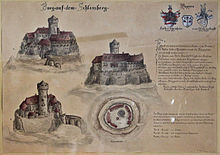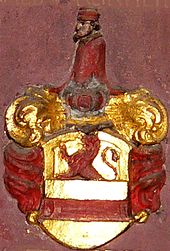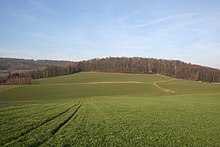Nieder-Modau Castle
| Nieder-Modau Castle | ||
|---|---|---|
|
Schlossberg Modau (photo montage) |
||
| Creation time : | 8/11 century | |
| Castle type : | Hilltop castle | |
| Conservation status: | Burgstall | |
| Place: | Nieder-Modau | |
| Geographical location | 49 ° 48 '24.7 " N , 8 ° 44' 29.4" E | |
| Height: | 280 m above sea level NHN | |
|
|
||
The castle Nieder-Modau is an Outbound hilltop castle on the Schlossberg at Modau , a district of Ober-Ramstadt , in the district of Darmstadt-Dieburg in Hesse .
location
The almost conical and now reforested Schlossberg is about 12 kilometers southeast of the city of Darmstadt in southern Hesse , in the area of the front Odenwald , north of Nieder-Modau and south of Ober-Ramstadt and is about 280 meters high. Today the O4 hiking trail in Ober-Ramstadt, the Silberbergweg , also leads over the Burgberg. The Modau flows around the mountain in half a loop from southwest to north .
history
The time of the construction of a castle, which supposedly stood on the Schlossberg until 1382, is still unknown today. In a volume "On the history of the Schloßberg near Nieder Modau" by Arthur Funk (published 1985), Rudolf Kunz suspects that the castle must have been built around 1200 by the Lords of Crumbach .
The Roßdorf geometer Georg Wilhelm Justin Wagner described the facility as follows in 1837:
“The plain on the Schloßberg has the shape of an ellipse, the long axis of which is 284 and the short axis of 184 feet long and has a circumference of 73 1/2 and a surface area of 410 fathoms. This area seems to have been surrounded by a circular wall, at least in individual places remains of this very solid and thick wall can still be found, some of which protrude a few feet above the ground , after the wall, is 20 feet deep. The area itself is criss-crossed by multiple wall foundations in all directions, which were discovered in 1827, when stones were broken out here for paving. [...] The question now arises who were the owners of this castle and at what time was it destroyed? This question can only be roughly solved. The author takes the liberty of expressing his opinion and his views here and leaves the examination of these to the judgment of a skilled researcher [...] ”.

The foundations of the curtain wall were uncovered during excavations in 1827. Today nothing can be seen of the aforementioned remains of the wall. In 1830, the chief forester Friedrich Heyer had the remaining wall remnants removed, the area was leveled and reforested with black pines, which were felled again in 1953/54 and replaced by linden trees. However, the ramparts and the southern access to the castle can be seen very well in the area.
The history of the castle before 1375 is unknown. The last lord of the castle was supposedly knight Werner Kalb from Reinheim , who went down in history as a robber baron . After he had initially committed to the city of Frankfurt am Main on August 25, 1375 in return for the payment of £ 12 "to waive all claims against the city of Frankfurt and its allies", he let them know on November 19, 1377:
“You know, Mayor and Councilor of Frankfurt, about such money that you have given me, I want to recite it and therefore never connect again. Send me back the letter you got from me. I also let you know that it seems to me that you have run over the agreement with me and would like to redin to eyme gelegelichin there and want to take a change from you. But if my friends realize that you owe me no change (change), you can save yourself a defense speech. Given with my seal of approval. "
In a letter dated September 21, 1381, the council of the city of Worms asks "Frankfurt as Confederates for support in combating the culprits" who have "harmed the Worms by taking away goods and imprisoning people". Werner Kalb von Reinheim “Follower of Heinrich von Beckingen ” can also be found on the slip of paper attached to this letter .
On November 28, 1381 the people of Frankfurt turned to Diether VIII von Katzenelnbogen . A note is attached to the letter:
"We and our allies have been damaged and attacked from your Reinheim Castle by Eberhard Schelm and his helpers."
Schelm was also on the list of robbers that the Worms had sent to the Frankfurters as a "follower of Heinrich von Beckingen". Since Diether VIII von Katzenelnbogen replied on the same day that he wanted to talk to him about Eberhard Schelm's affair and then answer Frankfurt, Arthur Funk assumes that Schelm and Kalb “were vassals of Count Diether and were under their own direction - but with the knowledge of the count - raids against the Frankfurt and Worms. "
After this escalation of the situation, all 18 comrades-in-arms met again at Tannenberg Castle near Seeheim, who had already concluded a truce on August 29, 1379 at Tannenberg Castle near Seeheim. These comrades-in-arms include Werner Kalb and Count Wilhelm II von Katzenelnbogen , the latter a founding member of the Lion League , which was founded on October 13, 1379 .
The Lion League was characterized by the hostile policy towards the cities. The reigns of Reifenberg and Kronberg , two declared enemies of Frankfurt, were founding members
The increasing influence of the Lion League, which expanded strongly to the south and got numerous new members, including Werner Kalb von Reinheim, prompted the affected cities to form a similar alliance. On March 20, 1381, the cities of Mainz, Strasbourg, Worms, Speyer, Frankfurt, Hagenau and Weißenburg agreed a union for mutual protection and protection (see also: Second Rhenish League of Cities ). This alliance, currently only valid until Christmas 1384, was expanded on June 6, 1382 and extended to 10 years and merged with the Swabian Federation to form the South German Association of Cities in the year it was founded. In this protective community it was decided that the cities of Frankfurt, Mainz and Worms should put an end to one of the main culprits, Werner Kalb von Reinheim.

Arthur Funk reconstructed the further event as follows:
“The 3 leaders of this joint force were apparently well informed about their mission. From Gernsheim they moved to Bergstrasse to visit the Tannenberg, with a special interest in the leader Werner Kalb, who was in the service of the Ganerbe . Without having achieved anything, the troops marched via Ober-Beerbach and Neutsch into the Modautal . According to the warfare of the time, this armed force, estimated by Walther Möller at a total strength of 150 to 160 Gleveners, must have lived barbarically in the villages of Nieder-Modau, Ober-Modau, Rohrbach, Wembach and Neutsch. "
"So it was not only the main goal, the Kalbsche castle on the Schloßberg near Nieder-Modau, but the whole area was sacked and destroyed. Cows, horses, pigs, sheep and household items were taken from the farmers and the torches were thrown into their filled barns and dwellings and devastated their gardens. We have no news of deaths, which certainly also existed. In this dispute not only Kalbscher property - among other things the large calving farms in Ober- and Nieder-Modau - were destroyed, but also many courts of the Counts von Katzenelnbogen and presumably also other lords and knights victims of robbery and flames. From the damage lists that were drawn up on the orders of Count Diether VIII and in which the damage to his 'poor luden' (his servants) was recorded, shows a number of 35 horses and 46 cows. Walther Möller is true with his total damage estimate of about 70 horses and just as many cows come closer. "
Numerous projectile stones were found around the Schlossberg, suggesting that both the attackers and the defenders used Bliden . The castle was allegedly destroyed in this dispute and not rebuilt. Their remains served as a quarry for centuries.
See also
Remarks
- ↑ quoted from: Arthur Funk: On the history of the Schloßberg near Nieder Modau. Ober-Ramstadt 1985, p. 15.
- ↑ Archive for Hessian History and Archeology, p. 403. Darmstadt 1837.
- ↑ Who were the gentlemen from the Schloßberg? In: Odenwälder Nachrichten 1938.
-
↑ Reconstruction drawings of the castle complex and further comments can be found in:
Hans von der Au: The field names of the districts of Ober- and Nieder-Modau in the Odenwald . Elwert Verlag, Gießen / Marburg 1942, p. 9 u. 71 ff. (= Hessian field names book 27). - ↑ Darmstädter Kreisblatt, September 22nd, 1982: Knight Werner Kalb loved to rob merchants.
- ↑ The Reichsministeriale von Dornberg (before 1160 those from Hagen-Münzenberg ) are (...) to be presumed to be the main rulers in the upper Modau valley and the most likely builders and owners of the castle near Nieder-Modau until they died out . Thomas Steinmetz: The southwestern tip of the Dreieich Wildbann in the Odenwald - a contribution to the history of the Upper Modau Valley and Nieder-Modau Castle. In: Der Odenwald , Zeitschrift des Breuberg-Bund, 2014, No. 2, p. 59.
- ↑ a b c d e from Arthur Funk: On the history of the Schloßberg near Nieder Modau. Ober-Ramstadt 1985.
- ^ Karl E. Demandt: The history of the state of Hesse .
- ↑ Arthur Funk: The history of the Schloßberg near Nieder-Modau. Ober-Ramstadt 1985, p. 58.
- ↑ More information on Bliden and their use: The destruction of Tannenberg Castle .
literature
- Hans von der Au : The names of the districts Ober- and Nieder-Modau in the Odenwald. Gießen / Marburg 1942. P. 71 ff.
- Karl Ernst Demandt : History of the State of Hesse. Stauda, Kassel 1980 (revised reprint of the 2nd, revised and expanded edition 1972), ISBN 3-7982-0400-4 .
- Arthur Funk: On the history of the Schloßberg near Nieder Modau. Ober-Ramstadt 1985.
- Rudolf Knappe: Medieval castles in Hessen. 800 castles, castle ruins and fortifications. 3rd edition, Wartberg Verlag , Gudensberg-Gleichen 2000, ISBN 3-86134-228-6 , p. 527.
- Walter Möller: The destruction of Modau Castle. In: The Odenwald . Zeitschrift des Breubergbund , vol. 2 (1955), p. 51.
- Konrad Ruser: On the history of the societies of masters, knights and servants in southern Germany during the 14th century. In: Zeitschrift für Württembergische Landesgeschichte , vol. 34/35 (1975/1976), pp. 1–100.
- Thomas Steinmetz: The southwestern tip of the Dreieich Wildbann in the Odenwald - a contribution to the history of the Upper Modau Valley and Nieder-Modau Castle. In: The Odenwald. Journal of the Breuberg-Bund , Volume 61 (2014) Issue 2, pp. 43–62.
- Olaf Wagener: The siege and destruction of the castle in Nieder-Modau in 1382 - new findings on siege systems. In: The Odenwald. Journal of the Breuberg-Bund , No. 60/1 (2013), pp. 23–28.
- Georg Wilhelm Justin Wagner : The Schlossberg near Niedermodau . In: Archive for Hessian History and Archeology. Section XXIII, Volume 1, Verlag Carl Wilhelm Leske, Darmstadt 1835, pp. 401-405.
- Georg Wilhelm Justin Wagner: Schloßberg . In: Wüstungen im Großherzogtum Hessen , Hofbuchhandlung G. Jonghaus, Darmstadt 1862, pp. 108-109.
- Helfrich Bernhard Wenck: Hessian national history. Volume 1 with a document book and geographical charts. Darmstadt and Giessen 1783.
- Arthur Funk: The castle in Nieder-Modau . In: Werner Hahn: Ober-Ramstadt - A chronicle of the history of the city . Published by the Magistrate of the City of Ober-Ramstadt, Ober-Ramstadt 2010, ISBN 978-3-9813356-0-6 , pp. 145–147.
Web links
- Documents from the County of Katzenelnbogen , HStAD Best. B 3 No. 1891, from the online database of the Hessian State Archives .
- Entry on Nieder-Modau Castle in the private database "Alle Burgen".
- Historical reconstruction drawing









